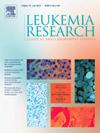A phase 2 study of itacitinib alone or in combination with low-dose ruxolitinib in patients with myelofibrosis
IF 2.2
4区 医学
Q3 HEMATOLOGY
引用次数: 0
Abstract
Background
The Janus kinase (JAK) 1/JAK2 inhibitor ruxolitinib has demonstrated efficacy/safety in patients with myelofibrosis; however, not all patients experience optimal and/or stable response, in part owing to dose-limiting toxicities. This phase 2 study evaluated itacitinib (JAK1-selective inhibitor) efficacy/safety alone or combined with low-dose ruxolitinib.
Methods
Cohort A received itacitinib 200 mg once daily (QD) plus ruxolitinib at a previous stable dose (≤15 mg total daily dose). Cohort B (previously ruxolitinib-treated) received itacitinib 600 mg QD alone. The primary endpoint was baseline-to-week 24 spleen volume reduction (SVR).
Results
Twenty-three patients were enrolled (median age, 71.0 years; intermediate-1/-2 risk, 73.9 %; Cohort A, n = 13; Cohort B, n = 10). Mean (standard deviation) percentage SVR from baseline was +6.9 % (27.5 %) and −3.0 % (34.7 %) in Cohorts A and B at week 24 (primary endpoint), and −1.6 % (14.7 %) and −24.6 % (21.7 %) in Cohorts A and B at week 12. SVR from baseline was achieved by 5 and 3 patients in Cohorts A and B at week 24, and by 9 and 7 patients in Cohorts A and B at week 12. Most common treatment-emergent adverse events (TEAEs) were anemia, diarrhea, and fatigue (each n = 8); most common grade ≥ 3 TEAEs were anemia (n = 6), thrombocytopenia (n = 5), fatigue (n = 3), and diarrhea (n = 2).
Conclusions
Overall, 8 of 23 patients enrolled achieved SVR at week 24; larger average changes in SVR at week 12 were observed for itacitinib monotherapy vs. the combination. No unexpected safety signals were observed.
一项单独使用伊他替尼或联合低剂量鲁索利替尼治疗骨髓纤维化患者的2期研究
Janus激酶(JAK) 1/JAK2抑制剂ruxolitinib已证明对骨髓纤维化患者有效/安全;然而,并非所有患者都有最佳和/或稳定的反应,部分原因是剂量限制性毒性。这项2期研究评估了itacitinib (jak1选择性抑制剂)单独或与低剂量ruxolitinib联合的有效性/安全性。方法肖特A接受伊他替尼200 mg每日一次(QD)加鲁索利替尼先前稳定剂量(≤15 mg总每日剂量)治疗。B组(先前接受ruxolitinib治疗)接受伊他替尼600 mg QD单独治疗。主要终点是基线至第24周脾脏体积减少(SVR)。结果共纳入23例患者(中位年龄71.0岁;中度-1/-2风险,73.9 %;队列A, n = 13;队列B, n = 10)。第24周(主要终点),A组和B组的基线平均(标准差)SVR百分比为+6.9 %(27.5% %)和- 3.0 %(34.7 %),第12周时,A组和B组的基线平均(标准差)SVR百分比为- 1.6 %(14.7 %)和- 24.6 %(21.7 %)。第24周时,A组和B组中分别有5名和3名患者达到基线SVR,第12周时,A组和B组中分别有9名和7名患者达到基线SVR。最常见的治疗不良事件(teae)是贫血、腹泻和疲劳(每个n = 8);最常见的等级≥ 3流泪贫血(n = 6),血小板减少症(n = 5),疲劳(n = 3)和腹泻(n = 2)。总体而言,23例入组患者中有8例在第24周达到SVR;在第12周,伊他替尼单药治疗与联合治疗相比,SVR的平均变化更大。没有观察到意外的安全信号。
本文章由计算机程序翻译,如有差异,请以英文原文为准。
求助全文
约1分钟内获得全文
求助全文
来源期刊

Leukemia research
医学-血液学
CiteScore
4.00
自引率
3.70%
发文量
259
审稿时长
1 months
期刊介绍:
Leukemia Research an international journal which brings comprehensive and current information to all health care professionals involved in basic and applied clinical research in hematological malignancies. The editors encourage the submission of articles relevant to hematological malignancies. The Journal scope includes reporting studies of cellular and molecular biology, genetics, immunology, epidemiology, clinical evaluation, and therapy of these diseases.
 求助内容:
求助内容: 应助结果提醒方式:
应助结果提醒方式:


